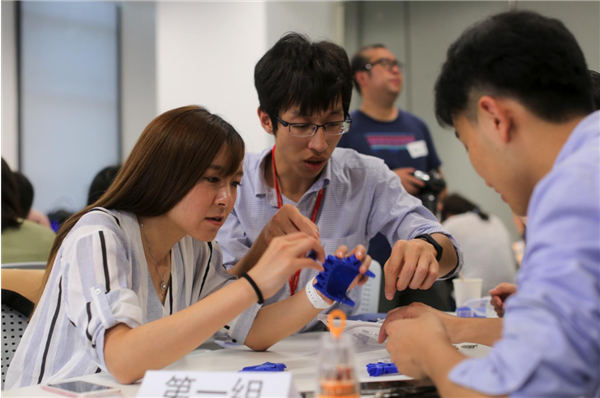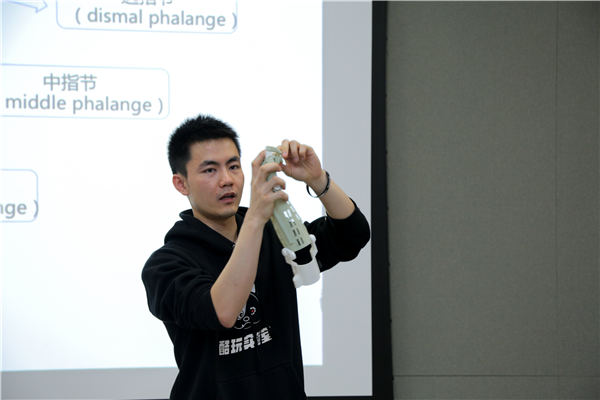
From the People's Daily app.
And this is Story in the Story.
The Chinese government recently announced new measures aimed at boosting technological advances and provide further incentives for Innovation while nurturing growth drivers.
China is home to almost 2.5 million children between the ages of 6 and 14 who live with disabilities, including some 500,000 with limb disabilities, according to China's Second National Sample Survey on Disability.
As 3D applications continue to emerge, hospitals, doctors, and design engineers are discovering ways to use the technology to help improve the quality of life for those in need.
"3D-printing enables doctors to treat patients more effectively and efficiently since it streamlines production," says Zhao Liwei, director of the prosthesis and orthosis fitting department at China's National Research Center for Rehabilitation Technical Aid.
Due to structural issues, 3D-printed prosthetics will not replace traditional ones in the immediate future, but thanks in part to the new measures aimed at innovation, that will change sooner rather than later.
Today's Story in the Story examines China’s innovation sector and how advanced technology like 3-D printing is making life better for those in need, as new reform measures on the way will only add to further technological breakthroughs.

A group of young people, employees of Johnson & Johnson, learn how to make 3D-printed prostheses at a workshop organized by the social enterprise Hands On in 2017. (Photo: China Daily)
The best package 11-year-old Zhang Jingtian ever received was his 3D-printed prosthetic hand.
"I've got my hand!" he shouted, after his mother helped him open the package.
Zhang, who was born without a left hand, had long wished for a prosthesis, but it was something his family could not afford.
Thanks to Hands On, a social and tech organization, his wish was finally realized.
The group's founder, 30-year-old Zhang Yan, who works in Google's Beijing office, learned about prosthetic 3D printing through online research beginning three years ago.
"The high-tech production of prostheses caught my attention," Zhang said.
Early on during his research he met Yu Yang, from Shandong Province, who was then trying to raise money for a 3D-printed prosthesis for her nine-year old son, Nan Nan.
Yu told Zhang that China has many children with limb disabilities, and some families can’t afford the costs associated with surgery and prostheses.
Regular manufactured prosthetic hands can cost upwards of $21,000 US dollars, but those made with 3D-printing technology are sold for $160.
"The price gap made me realize the value of 3D-printed prosthetics," Zhang said.
Yu introduced Zhang to a social media group with 2,000 members that included parents, doctors, and others who wanted to help children with limb disabilities.
Zhang met Su Jiangzhou, a mechanical engineering post-grad at the Beijing Institute of Technology who had a passion for 3D printing.
Su had already won an award for one of his prosthetic designs, but it wasn't that useful. He later refined the original model to make it more applicable.
Su reached out to Enabling the Future, an open-source design network for 3D-printing technology focused on prosthetic hands and arms.
"Their designs far exceeded mine at the time," Su admitted.
"After I discovered their models hadn't been used in China, I asked for the group's support to introduce them to the country," Su explained.

Zhang Yan, initiator and co-founder of Hands On, talks about 3D-printed prosthetic hands at a workshop. (Photo: China Daily)
Zhang and Su, along with three other friends, launched Hands On in 2015. To this day, the group dedicates their free time designing and producing 3D-printed hands for children, free of charge.
Su continued with his research and the start-up eventually developed original products.
"Once we made progress with a design, we found more families with children who needed a prosthetic. We also contacted people we'd helped earlier to offer them better replacements," Su recalled.
In 2015, they donated over 90 3D printed hands to almost 60 children.
Hands On has grown over the years, but still struggles with funding. They offer workshops for those interested in learning more about 3D printing technology.
"We have long-term cooperation agreements with companies like Johnson & Johnson, Microsoft and Bayer," Zhang said.
Mao Qingge, senior director of consumer products at Johnson & Johnson's Asia-Pacific Innovation Center said, "Our workshop with Hands On is a social innovation, focused on welfare and philanthropy.
In August, Hands On won the coveted Asia-Pacific Youth Sustainable Development Goal Entrepreneurship Award at the Asia-Pacific Forum on Youth Leadership, Innovation and Entrepreneurship organized by the United Nations Development Program.
Hands On now has volunteer communities in Beijing, Shanghai and Guangzhou where people can study design models and learn more about disabilities.
So far, over 250 volunteers have joined the Hands On communities, while 10 have mastered 3D printing technology.
Zhao Liwei, director of the prosthesis department at China's National Research Center for Rehabilitation Technical Aid acknowledged that the materials used in 3D printing are limited.
"The 3D printer cannot handle complicated details very well, so its development in the prosthetic sector in China needs further attention, and we hope more young people will devote themselves to this field,” Zhao said.
(Produced by Nancy Yan Xu, Brian Lowe, Lance Crayon, and Chelle Wenqian Zeng. Music by: bensound.com. Text from Global Times and China Daily.)


